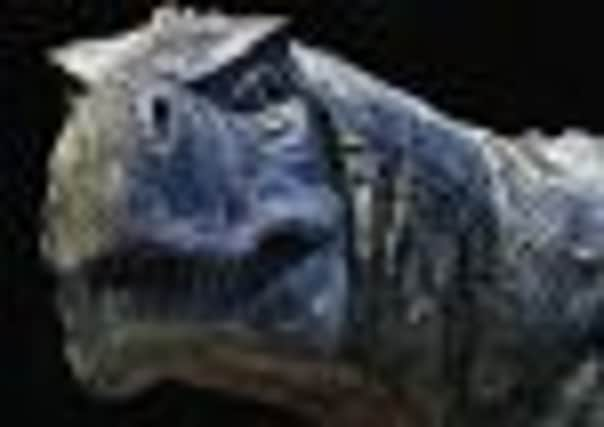Ian Swanson: City team closer to Jurassic science


Researchers at Edinburgh University’s Roslin Institute, which was behind Dolly the Sheep, the world’s first cloned mammal, have developed a way of bringing chicken breeds back to life.
And now they hope to take the work further and extend the technique to other species of birds.
Advertisement
Hide AdAdvertisement
Hide AdElsewhere similar “de-extinction” work is going on to find ways of resurrecting animals which vanished from the earth hundreds or even thousands of years ago. So could the fantasy of Jurassic Park soon become 21st century reality?
Dutch scientists hope to revive the aurochs, a type of wild cattle hunted to extinction in the 17th century, by selectively breeding from seven breeds of closely-related primitive cattle.
A Canadian academic has said mammoths – which became extinct 10,000 years ago – could be lumbering across Eurasian landscapes within a decade or two if scientists can analyse DNA from carcasses deep frozen in Siberia and use it to rewrite the genome of the Asian elephant until it matches the mammoth’s.
And in America, work is ongoing to resurrect the passenger pigeon, one of the most common birds in the 19th century, but hunted to extinction in the 20th. Researchers are piecing together its genome from a 100-year-old stuffed museum specimen.
Advertisement
Hide AdAdvertisement
Hide AdDr Mike McGrew, the man leading the project at Roslin, explains the purpose of his research is to be able to freeze and store sex stem cells from various breeds of chicken so that in the event of an epidemic – say, of bird flu – which wiped out Scotland’s chicken population, the genetic material would be preserved, allowing a vital food source to be recreated.
The new National Avian Research Facility, due to open at Roslin in the autumn of this year, will become the storage centre for what Dr McGrew describes as a “frozen aviary”. He said: “We are making a stem cell biobank for chickens – a frozen zoo for avian species, preserving genetic resources for commercial breeds and species that are going to be lost. It’s really important for bio-security. We would have the original cells stored away. For chickens, we have developed a technique where we can do that very easily. And we are hoping to extend that to do the same with other bird species.
“Many rare breeds of chicken are being lost – the idea is if we have them frozen away they would not be lost forever.
“There are already some frozen zoos, but most have cell samples which they freeze and store away, saying ‘some day we’ll learn how to clone these animals’. But we are already making it work very effectively for chickens, we know how to bring them back.” Dr McGrew described his work to an international conference on de-extinction last week. He also spoke about the work of other scientists who extracted chicken sperm cells and put them into ducks so the duck produced chicken sperm. It then mated with a hen to produce normal chickens.
Advertisement
Hide AdAdvertisement
Hide AdIt is this approach which scientists believe could resurrect some extinct species, if DNA samples are available.
But Dr McGrew says there are wider questions than the technical ability to carry out the procedures.
He says: “If there is no ecosystem, where are we going to put these animals? And if a species became extinct, why should we bring it back?”
At the conference, Australian professor Michael Archer argued that if a species was recently made extinct by man – such as the thylacine or Tasmanian tiger, the last one of which was shot in 1930 – there was a moral obligation to correct that mistake.
Advertisement
Hide AdAdvertisement
Hide AdOthers fear the ability to bring back animals from extinction will cause people to be less concerned about saving endangered species.
Libby Anderson of animal campaign group OneKind, is wary of the idea of “designer” animals.
She says: “It has to be questioned whether bringing back the mammoths or resurrecting the Pyrenean ibex does anything for the animals themselves.
“Extinction is unfortunately a natural phenomenon and attempts to keep species alive are often of no benefit to the individual members of species.
Advertisement
Hide AdAdvertisement
Hide Ad“Individual animals do pay a price by being involved in scientific procedures and it would be important to know the justification for using animals in this way.”‘CLONEDIDATES’ FOR HI-TECH REVIVAL
caption: words in here
aurochs – A type of large wild cattle which inhabited Europe, Asia and North Africa. The last recorded one died in 1627.
MAMMOTH – Elephant-like creatures with long, curved tusks and long hair which and became extinct around 10,000 years ago.
THYLACINE – Tasmanian tiger, the largest known carnivorous marsupial of modern times. The last one is said to have been shot by a farmer in 1930.
Advertisement
Hide AdAdvertisement
Hide AdPASSENGER PIGEON – Once one of the world’s most common birds, they lived in huge migratory flocks. The last one died in Cincinnati Zoo in 1914.
GREAT AUK – A large flightless penguin-like bird, hunted to extinction around 1852.
PYRENEAN IBEX – The last female was killed in 2000. Her tissue was cloned and at least one foetus survived to term in a surrogate mother goat. It died after birth.